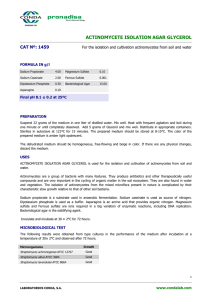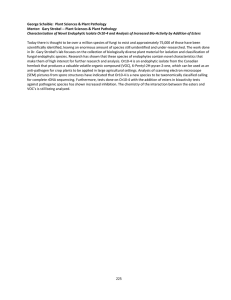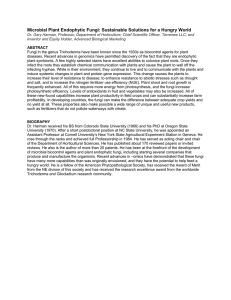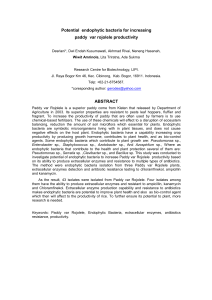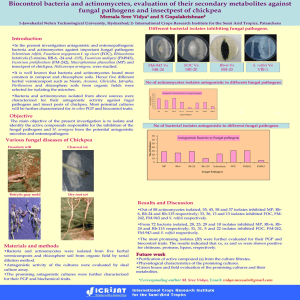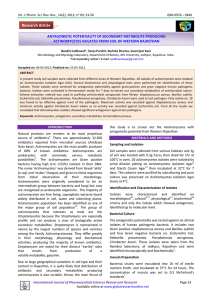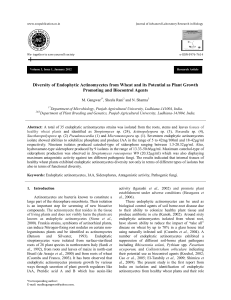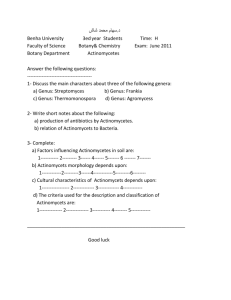Antagonistic Bioactivity of Endophytic Actinomycetes Isolated from Medicinal Plants
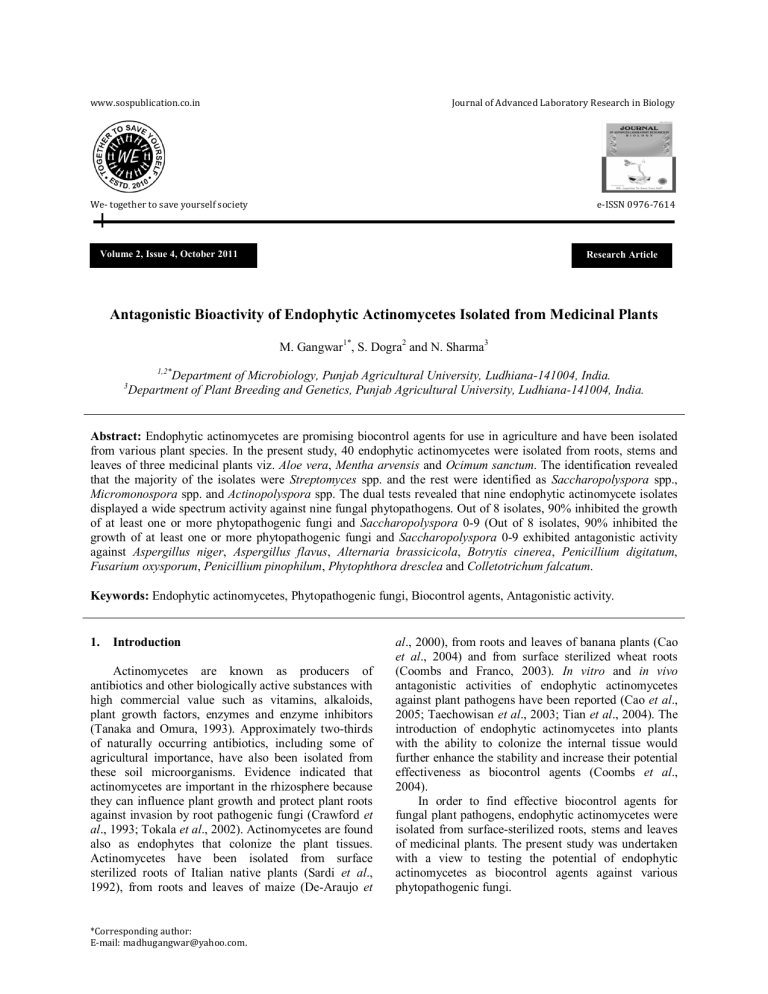
www.sospublication.co.in
Journal of Advanced Laboratory Research in Biology
We- together to save yourself society e-ISSN 0976-7614
Volume 2, Issue 4, October 2011 Research Article
Antagonistic Bioactivity of Endophytic Actinomycetes Isolated from Medicinal Plants
M. Gangwar
1*
, S. Dogra
2
and N. Sharma
3
1,2*
Department of Microbiology, Punjab Agricultural University, Ludhiana-141004, India.
3
Department of Plant Breeding and Genetics, Punjab Agricultural University, Ludhiana-141004, India.
Abstract: Endophytic actinomycetes are promising biocontrol agents for use in agriculture and have been isolated from various plant species. In the present study, 40 endophytic actinomycetes were isolated from roots, stems and leaves of three medicinal plants viz. Aloe vera , Mentha arvensis and Ocimum sanctum . The identification revealed that the majority of the isolates were Streptomyces spp. and the rest were identified as Saccharopolyspora spp.,
Micromonospora spp. and Actinopolyspora spp. The dual tests revealed that nine endophytic actinomycete isolates displayed a wide spectrum activity against nine fungal phytopathogens. Out of 8 isolates, 90% inhibited the growth of at least one or more phytopathogenic fungi and Saccharopolyspora 0-9 (Out of 8 isolates, 90% inhibited the growth of at least one or more phytopathogenic fungi and Saccharopolyspora 0-9 exhibited antagonistic activity against Aspergillus niger , Aspergillus flavus , Alternaria brassicicola , Botrytis cinerea , Penicillium digitatum ,
Fusarium oxysporum , Penicillium pinophilum , Phytophthora dresclea and Colletotrichum falcatum .
Keywords: Endophytic actinomycetes, Phytopathogenic fungi, Biocontrol agents, Antagonistic activity.
1.
Introduction
Actinomycetes are known as producers of antibiotics and other biologically active substances with high commercial value such as vitamins, alkaloids, plant growth factors, enzymes and enzyme inhibitors
(Tanaka and Omura, 1993). Approximately two-thirds of naturally occurring antibiotics, including some of agricultural importance, have also been isolated from these soil microorganisms. Evidence indicated that actinomycetes are important in the rhizosphere because they can influence plant growth and protect plant roots against invasion by root pathogenic fungi (Crawford et al ., 1993; Tokala et al ., 2002). Actinomycetes are found also as endophytes that colonize the plant tissues.
Actinomycetes have been isolated from surface sterilized roots of Italian native plants (Sardi et al .,
1992), from roots and leaves of maize (De-Araujo et al ., 2000), from roots and leaves of banana plants (Cao et al ., 2004) and from surface sterilized wheat roots
(Coombs and Franco, 2003). In vitro and in vivo antagonistic activities of endophytic actinomycetes against plant pathogens have been reported (Cao et al .,
2005; Taechowisan et al ., 2003; Tian et al ., 2004). The introduction of endophytic actinomycetes into plants with the ability to colonize the internal tissue would further enhance the stability and increase their potential effectiveness as biocontrol agents (Coombs et al .,
2004).
In order to find effective biocontrol agents for fungal plant pathogens, endophytic actinomycetes were isolated from surface-sterilized roots, stems and leaves of medicinal plants. The present study was undertaken with a view to testing the potential of endophytic actinomycetes as biocontrol agents against various phytopathogenic fungi.
*Corresponding author:
E-mail: madhugangwar@yahoo.com.
Antagonistic Bioactivity of Endophytic Actinomycetes Gangwar et al
2.
Materials and Methods
2.1 In vitro antagonistic bioassay
The actinomycete isolates were evaluated for their activity towards nine pathogenic fungi: Aspergillus niger , Aspergillus flavus , Alternaria brassicicola ,
Botrytis cinerea , Penicillium digitatum ,
Fusarium oxysporum , Penicillium pinophilum ,
Phytophthora dresclea and Colletotrichum falcatum by dual-culture in vitro assay. Fungal discs (8mm in diameter), 5 days old on PDA at 28ºC were placed at the center of PDA plates. Two actinomycete discs
(8mm) 5 days old, grown on yeast malt extract (YM) incubated at 28ºC were placed on opposite sides of the plates, 3cm away from fungal disc. Plates without the actinomycete disc serve as controls. All the plates were incubated at 28ºC for 14 days and colony growth inhibition (%) was calculated by using the formula: C –
T/C x 100, where C is the colony growth of pathogen in control and T is the colony growth of pathogen in dual culture. The zone of inhibition was measured between the pathogen and actinomycete isolates (Khamna et al .,
2009).
3.
Results and Discussion
3.1 Antifungal activities
Eight (20%) of actinomycete isolates were active against at least one of the nine phytopathogenic fungi
(Table 1).
Different isolates of Streptomyces spp. displayed an array of activity against pathogenic fungi, particularly S. albosporus A4, an Aloe vera isolate and
Table 1. Antifungal activity of actinomycete isolates.
Percentage (%) inhibition a
O-11, an Ocimum sanctum isolate. This is in conformity with the results of several studies carried out by other investigators (Crawford et al., 1993; Taechowisan and
Lumyong, 2003; Tian et al., 2004; Verma et al ., 2009).
Saccharopolyspora O-9 from Ocimum sanctum strongly inhibited all of the pathogenic fungi (Fig. 1) with maximum percent inhibition was observed against the fungus Penicillium digitatum (71.4%).
Actinomycetes-fungus antagonism has been demonstrated for a variety of plant pathogens such as
Alternaria, Rhizoctonia, Verticillium, Fusarium,
Phytophthora and Pythium spp. (Yuan and Crawford,
1995; Aghighi et al., 2004). The ability of isolates to inhibit the growth of fungal pathogens is implication of the volatile secondary metabolites secreted by actinomycetes. So, in the present study, the potential of endophytic actinomycetes to inhibit the growth of pathogens has been studied. Dual-culture assays showed that some actinomycetes isolated can be developed as potential biocontrol agents. Therefore, further studies are necessary to assess the ability of the isolates to confer protection against pathogens and their role in enhancing growth and yield of plants under field conditions.
In conclusion, all but one of our Streptomyces isolates tested displayed antifungal activity. In addition, to Streptomyces, the medicinal plants carried rare actinomycetes all of which displayed antifungal activity with Saccharopolyspora being the potent antagonist.
Our survey suggested that medicinal plants are a potent source of endophytic actinomycetes with wide biological activity against pathogenic fungi.
Actinomycete isolates
Micromonospora O-14
S. viridis A3
S. albosporus A4
S. cinereus A6
Micromonospora A9
0
0
0
0
11.4 ± 0.2 14.5 ± 0.1
0 0
0 0
0
0
0
0
0
62.2 ± 0.1 19.5 ± 0.1 12.6 ± 0.1
39.6 ± 0.2 22.8 ± 0.1 45.8 ± 0.1
0
0
63.5 ± 0.1 60.6 ± 0.1 19.8 ± 0.2
42.4 ± 0.08 0
0
17.6 ± 0.1 34.5 ± 0.2
40.3 ± 0.2 0 48.5 ± 0.2 0
S. cinereus O-1 0 0 0 25.3 ± 0.1 15.2 ± 0.1 0 0 0 42.6 ± 0.1
Saccharopolyspora O-9 13.2 ± 0.2 28.6 ± 0.1 26.5 ± 0.2 30.5 ± 0.1 71.4 ± 0.2 51.4 ± 0.1 17.8 ± 0.1 56.4 ± 0.1 49.9 ± 0.1
S. albosporus O-11 16.7 ± 0.1 17.5 ± 0.2 a
Average ± standard error from triplicate samples
0 44.6 ± 0.2 18.6 ± 0.1 59.5 ± 0.2 0 53.5 ± 0.2 53.4 ± 0.2
16 ± 0.1 16.1 ± 0.1
0 17.4 ± 0.1
69.3 ± 0.3 57.9 ± 0.1
0 0
13.9 ± 0.1 0
J. Adv. Lab. Res. Biol. 155
Antagonistic Bioactivity of Endophytic Actinomycetes Gangwar et al
A B C
D E F
G H I
Fig. 1. Inhibition effect of Saccharopolyspora O-9 against Penicillium digitatum (A), Fusarium oxysporum (B), Aspergillus niger (C),
Colletotrichum falcatum (D), Botrytis cinerea (E), Aspergillus flavus (F), Phytophthora dresclea (G), Alternaria brassicicola (H) and Penicillium
pinophilum (I), Penicillium digitatum
References
[1].
Aghighi, S., Bonjar, G.H.S., Rawashdeh, R.,
Batayneh, S. and Saadoun, I. (2004). First Report of Antifungal Spectra of Activity of Iranian
Actinomycetes Strains Against Alternaria solani ,
Alternaria alternate , Fusarium solani ,
Phytophthora megasperma , Verticillium dahliae and Saccharomyces cerevisiae. Asian J. Plant
Sci., 3 : 463-71.
[2].
Cao, L., Qiu, Z., You, J., Tan, H. and Zhou, S.
(2004). Isolation and characterization of endophytic Streptomyces strain from surface sterilized tomato ( Lycopersicon esculentum ) roots.
Lett. Appl. Microbiol., 39: 425-30.
[3].
Cao, L., Qiu, Z., You, J., Tan, H. and Zhou, S.
(2005). Isolation and Characterization of endophytic streptomycete antagonists of Fusarium wilt pathogen from surface-sterilized banana roots. FEMS Microbiol. Lett., 247 : 147-52.
[4].
Coombs, J.T. and Franco, C.M.M. (2003).
Isolation and identification of actinobacteria from surface-sterilized wheat roots. Appl. Environ.
Microbiol., 69 : 5603-08.
[5].
Coombs, J.T., Michelsen, P.P. and Franco,
C.M.M. (2004). Evaluation of endophytic bacteria as antagonists of Gaeumannomyces graminis var. tritici in wheat. Biol. Control, 29 : 359-66.
[6].
Crawford, D.L., Lynch, J.M., Whipps, J.M. and
Ousley, M.A. (1993). Isolation and characterization of actinomycete antagonistic of a fungal root pathogen. Appl. Environ. Microbiol.,
59 : 3899-05.
[7].
Araujo, J.M., Silva, A.C. & Azevedo, J.L. (2000).
Isolation of endophytic actinomycetes from roots and leaves of maize ( Zea mays L.). Brazilian
Archives of Biology and Technology , 43: 447–
451.
[8].
Khamna, S., Yokota, A. and Lumyong, S. (2009).
Actinomycetes isolated from medicinal plant
J. Adv. Lab. Res. Biol. 156
Antagonistic Bioactivity of Endophytic Actinomycetes Gangwar et al rhizosphere soil: diversity and screening of antifungal compound, indole-3-acetic acid and siderophore production. World J. Microbiol.
Biotechnol., 25 : 649-55.
[9].
Sardi, P., Saracchi, M., Quaroni, S., Petrolini, B.,
Borgonovi, G.E. and Merli, S. (1992). Isolation of endophytic Streptomyces strains from surfacesterilized roots. Appl. Environ. Microbiol., 58 :
2691-93.
[10].
Taechowisan, T. and Lumyong, S. (2003).
Activity of endophytic actinomycetes from roots of Zingiber officinale and Alpinia galanga against phytopathogenic fungi. Ann. Microbiol., 53 : 291-
98.
[11].
Taechowisan, T., Peberdy, J.F. and Lumyong, S.
(2003). Isolation of endophytic actinomycetes from selected plants and their antifungal activity.
World J. Microbiol. Biotechnol., 19 : 381-85.
[12].
Tanaka, Y. and Omura, S. (1993). Agroactive compounds of microbial origin. Ann. Rev.
Microbiol., 47 : 57-87.
[13].
Tian, X.L., Cao, L.X., Tan, H.M., Zeng, Q.G., Jia,
Y.Y., Han, W.Q. & Zhou, S.N. (2004). Study on the communities of endophytic fungi and endophytic actinomycetes from rice and their antipathogenic activities in vitro . World J.
Microbiol. Biotechnol., 20 : 303-09.
[14].
Tokala, R.K., Strap, J.L., Jung, C.M., Crawford,
D.L., Salove, M.H., Deobald, L.A., Bailey, J.F. and Morra, M.J. (2002). Novel Plant microbe rhizosphere interaction involving Streptomyces lydicus WYEC108 and the Pea plant ( Pisum sativum ). Appl. Environ. Microbiol., 68 : 2161-71.
[15].
Verma, V.C., Gond, S.K., Kumar, A., Mishra, A.,
Kharwar, R.N. and Gange, A.C. (2009).
Endophytic actinomycetes from Azadirachta indica A. Juss.: Isolation, diversity and antimicrobial activity. Microb. Ecol., 57 : 749-56.
[16].
Yuan, W.M. and Crawford, D.L. (1995).
Characterization of Streptomyces lydicus
WYEC108 as a potential biocontrol agent against fungal root and seed rots. Appl. Environ.
Microbiol., 61 : 3119-28.
J. Adv. Lab. Res. Biol. 157
